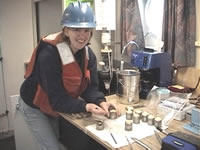|
Participant Perspective - July
23, 2001
 Interview
with Susan Kulp Interview
with Susan Kulp
Geologist - University of Florida
Jeff:
What project are you working on along the Juan de Fuca Ridge?
Susan:
My project deals with a location south of Axial Volcano on the south Cleft
segment of the Juan de Fuca Ridge. I'm looking at the intersection of
the southern Cleft segment of Juan de Fuca Ridge with the Blanco Fracture
Zone, a big transform fault. I'm studying the "cold edge effect."
It's a geochemical phenomenon that occurs due to the interaction of the
hydrothermally active ridge with the hydrothermally inactive transform
fault. The Blanco Fracture Zone basically cools down and truncates the
magma chamber underneath the ridge. This causes melting to occur more
quickly, and the magma doesn't have as much time to crystallize. It results
in lava melts that have a different geochemical signature at the Blanco
intersection than it would farther to the north or south. I'm also looking
at the structure of the southern Cleft segment and how it relates to the
frequency of the eruptions. The current non-steady-state model for the
ridge's formation states that eruptions don't happen continuously. The
high axial ridge builds during the eruptions. When the magma supply is
cut off during the extension process the axial ridge collapses forming
the axial valley along the southern Cleft segment.
Jeff:
Did you have a rock collection as a kid?
Susan:
No, I didn't. At one point I thought that looking at rocks was boring.
Then in college I took an oceanography class and that's where I first
learned about plate tectonics. I thought it was the most amazing thing
I've ever heard. It's incredible. Before, I had a lot of misconceptions
about what geologists do. Once I found out that it's a whole new world
of exploration I was hooked. I love plate tectonics as a whole. I get
excited about anything dealing with the plates spreading or moving. I've
always been interested in the Juan de Fuca ridge because it's a little
plate off the west coast and there's subduction and the creation of the
plate. It's exciting for me. I really just like the active processes of
geology and am more interested in tectonics than sedimentation. I'm more
interested in the active than the passive.
Jeff:
Does our public education system expose students enough to geology and
the earth sciences?
Susan:
No. I think it's a shame that a lot of school systems don't stress the
Earth Sciences. We need students to be exposed to Earth Science. All of
the other sciences, such as biology and chemistry, have their practical
applications. You can make money off them right away, for instance, pharmaceuticals.
However, we still need to understand how the Earth works. As geologists
we study the history of the Earth and the Earth processes that are going
on right now. We need geologists to understand our planet and the other
planets in our solar system. There are so many different aspects of geology
that you can get yourself into. Because geology it is under-appreciated
and relatively misunderstood, we definitely need Earth Science at the
younger levels in public education.
|

